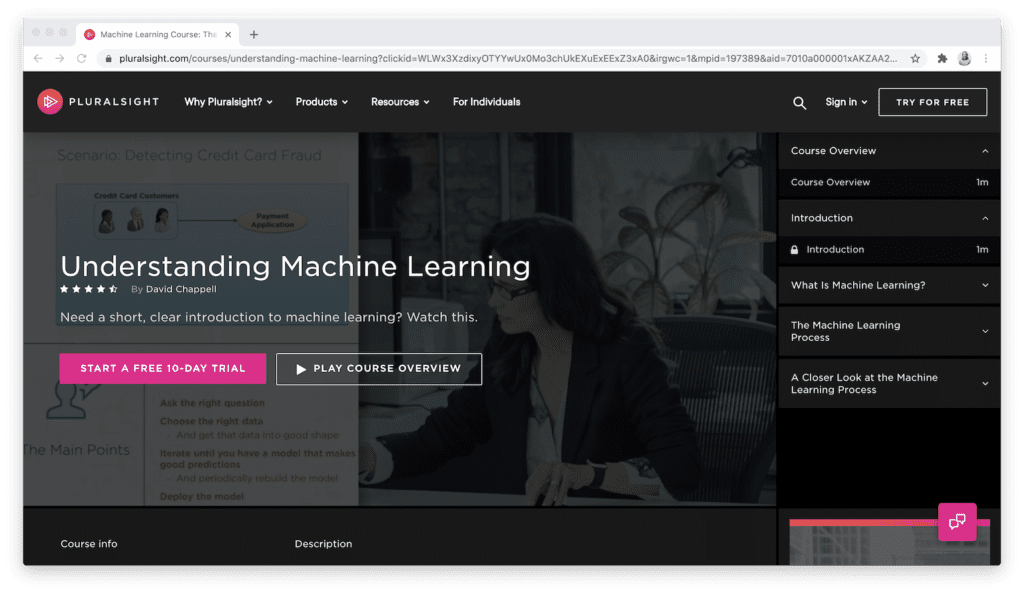All Categories
Featured
Table of Contents
- – Facts About Machine Learning Certification Tra...
- – Little Known Facts About Machine Learning Cras...
- – Some Known Incorrect Statements About Embarki...
- – Things about How To Become A Machine Learning...
- – What Does Top Machine Learning Careers For 2...
- – The Best Strategy To Use For New Course: Gen...
You probably recognize Santiago from his Twitter. On Twitter, every day, he shares a whole lot of practical things regarding device knowing. Alexey: Prior to we go right into our major subject of relocating from software engineering to machine discovering, maybe we can begin with your history.
I went to university, obtained a computer system scientific research level, and I started developing software program. Back after that, I had no idea concerning equipment understanding.
I recognize you have actually been making use of the term "transitioning from software application design to equipment understanding". I such as the term "including to my capability the artificial intelligence skills" more since I think if you're a software program engineer, you are already providing a whole lot of value. By integrating machine knowing currently, you're augmenting the impact that you can have on the market.
Alexey: This comes back to one of your tweets or possibly it was from your training course when you compare 2 techniques to learning. In this case, it was some issue from Kaggle concerning this Titanic dataset, and you simply learn exactly how to address this problem making use of a details tool, like choice trees from SciKit Learn.
Facts About Machine Learning Certification Training [Best Ml Course] Revealed
You first learn math, or direct algebra, calculus. When you understand the mathematics, you go to equipment understanding theory and you discover the theory.
If I have an electric outlet right here that I need changing, I don't wish to go to college, spend 4 years understanding the mathematics behind power and the physics and all of that, simply to change an electrical outlet. I prefer to start with the outlet and find a YouTube video clip that helps me go with the trouble.
Negative analogy. But you get the idea, right? (27:22) Santiago: I actually like the idea of starting with a problem, trying to throw away what I recognize approximately that issue and recognize why it doesn't function. Get the tools that I need to resolve that problem and begin excavating deeper and deeper and deeper from that point on.
Alexey: Perhaps we can speak a little bit about discovering sources. You discussed in Kaggle there is an intro tutorial, where you can obtain and learn just how to make choice trees.
The only need for that course is that you recognize a little bit of Python. If you go to my account, the tweet that's going to be on the top, the one that claims "pinned tweet".
Little Known Facts About Machine Learning Crash Course.

Also if you're not a programmer, you can start with Python and function your method to more artificial intelligence. This roadmap is focused on Coursera, which is a system that I actually, really like. You can investigate all of the training courses totally free or you can pay for the Coursera registration to obtain certifications if you wish to.
Alexey: This comes back to one of your tweets or possibly it was from your course when you contrast two strategies to learning. In this instance, it was some issue from Kaggle about this Titanic dataset, and you simply discover just how to solve this issue utilizing a details device, like choice trees from SciKit Learn.
You first learn mathematics, or linear algebra, calculus. When you understand the math, you go to equipment learning concept and you learn the concept.
If I have an electric outlet below that I need changing, I do not intend to most likely to college, spend four years understanding the mathematics behind electricity and the physics and all of that, simply to change an outlet. I prefer to start with the outlet and locate a YouTube video that assists me experience the issue.
Santiago: I actually like the idea of beginning with an issue, trying to throw out what I know up to that trouble and understand why it does not work. Get the devices that I need to resolve that issue and start digging much deeper and deeper and much deeper from that point on.
To ensure that's what I generally advise. Alexey: Maybe we can talk a bit about discovering resources. You pointed out in Kaggle there is an introduction tutorial, where you can obtain and learn how to make decision trees. At the start, prior to we began this interview, you stated a pair of books.
Some Known Incorrect Statements About Embarking On A Self-taught Machine Learning Journey
The only requirement for that program is that you recognize a little bit of Python. If you go to my account, the tweet that's going to be on the top, the one that states "pinned tweet".
Also if you're not a programmer, you can start with Python and function your means to even more equipment knowing. This roadmap is concentrated on Coursera, which is a platform that I truly, really like. You can audit all of the courses completely free or you can pay for the Coursera membership to obtain certificates if you intend to.
Things about How To Become A Machine Learning Engineer [2022]
That's what I would do. Alexey: This returns to among your tweets or maybe it was from your course when you contrast two approaches to knowing. One technique is the trouble based strategy, which you just discussed. You find an issue. In this instance, it was some trouble from Kaggle about this Titanic dataset, and you just find out exactly how to resolve this issue using a specific device, like choice trees from SciKit Learn.

You first discover mathematics, or straight algebra, calculus. When you understand the math, you go to equipment understanding theory and you learn the concept. After that four years later, you lastly come to applications, "Okay, how do I use all these four years of mathematics to resolve this Titanic issue?" Right? In the former, you kind of save yourself some time, I think.
If I have an electrical outlet here that I require changing, I do not wish to most likely to university, spend 4 years understanding the mathematics behind electricity and the physics and all of that, just to transform an outlet. I would instead start with the electrical outlet and find a YouTube video that helps me undergo the trouble.
Santiago: I actually like the concept of starting with an issue, attempting to throw out what I recognize up to that problem and comprehend why it doesn't work. Get hold of the devices that I require to address that issue and begin excavating deeper and deeper and much deeper from that factor on.
So that's what I typically advise. Alexey: Possibly we can talk a bit concerning discovering resources. You mentioned in Kaggle there is an introduction tutorial, where you can obtain and learn exactly how to make choice trees. At the beginning, before we started this meeting, you pointed out a couple of publications also.
What Does Top Machine Learning Careers For 2025 Do?
The only requirement for that course is that you understand a little bit of Python. If you go to my account, the tweet that's going to be on the top, the one that says "pinned tweet".
Even if you're not a programmer, you can start with Python and function your method to more equipment learning. This roadmap is concentrated on Coursera, which is a platform that I really, actually like. You can audit every one of the courses totally free or you can pay for the Coursera membership to get certificates if you wish to.
Alexey: This comes back to one of your tweets or maybe it was from your course when you compare 2 approaches to discovering. In this case, it was some problem from Kaggle regarding this Titanic dataset, and you simply find out just how to resolve this issue making use of a details device, like choice trees from SciKit Learn.
You first learn math, or straight algebra, calculus. When you understand the mathematics, you go to machine knowing concept and you learn the concept.
The Best Strategy To Use For New Course: Genai For Software Developers
If I have an electric outlet right here that I need replacing, I do not intend to most likely to university, spend four years recognizing the mathematics behind electrical power and the physics and all of that, just to change an electrical outlet. I prefer to start with the outlet and find a YouTube video that helps me undergo the trouble.
Bad analogy. Yet you understand, right? (27:22) Santiago: I really like the idea of starting with a problem, attempting to throw away what I understand approximately that trouble and recognize why it does not work. Then get hold of the tools that I need to address that trouble and start digging deeper and much deeper and much deeper from that point on.

Alexey: Possibly we can speak a little bit regarding finding out sources. You pointed out in Kaggle there is an introduction tutorial, where you can obtain and find out just how to make choice trees.
The only requirement for that course is that you understand a little of Python. If you're a developer, that's a great starting factor. (38:48) Santiago: If you're not a developer, then I do have a pin on my Twitter account. If you go to my account, the tweet that's mosting likely to be on the top, the one that claims "pinned tweet".
Also if you're not a designer, you can start with Python and work your way to more device understanding. This roadmap is focused on Coursera, which is a platform that I actually, actually like. You can examine every one of the training courses completely free or you can spend for the Coursera subscription to get certifications if you intend to.
Table of Contents
- – Facts About Machine Learning Certification Tra...
- – Little Known Facts About Machine Learning Cras...
- – Some Known Incorrect Statements About Embarki...
- – Things about How To Become A Machine Learning...
- – What Does Top Machine Learning Careers For 2...
- – The Best Strategy To Use For New Course: Gen...
Latest Posts
10 Proven Strategies To Ace Your Next Software Engineering Interview
The Best Courses To Prepare For A Microsoft Software Engineering Interview
Software Developer Career Guide – From Interview Prep To Job Offers
More
Latest Posts
10 Proven Strategies To Ace Your Next Software Engineering Interview
The Best Courses To Prepare For A Microsoft Software Engineering Interview
Software Developer Career Guide – From Interview Prep To Job Offers